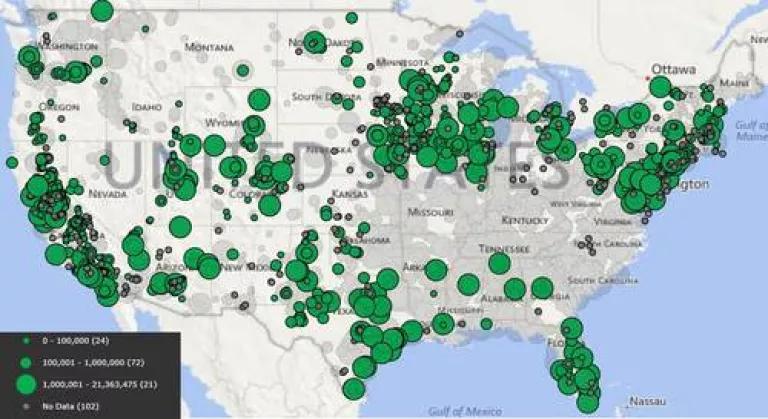
The Environmental Protection Agency has proposed the first-ever limits on carbon pollution from the nation's existing power plants, and has received an unprecedented number of comments supporting critical steps to help avoid the worst impacts of climate change. An initial review of comments from power companies reveals that a large number of America's power providers from across the country are constructively engaged regarding the EPA's Clean Power Plan proposal. The following power companies either express support for the plan or acknowledge that the EPA will issue final standards to cut carbon pollution, and offer recommendations on how the agency can issue fair and improved standards this summer.
The following power providers submitted constructive comments:
The power providers on this list generate 24% of the power in the U.S. and serve over 45 million customers (analysis of SNL data). The map below shows the power plants these companies own in green and dark gray, and all other power plants in light gray (map by SNL Maps). Power plants are sized by generation.
Location of Power Plants Owned by Constructive Companies

The following are some examples of what companies are saying broadly about the rule:
- NextEra "supports the Clean Power Plan as a reasonable and balanced approach to reducing CO2 emissions from the electric generating sector that is consistent with the CAA and EPA's implementing regulations." (NextEra Energy, Inc.)
- "The Proposed Clean Power Plan would set state-by-state carbon dioxide ('CO2') emissions standards and encourage flexible, market-based and technology-neutral solutions to meet the standards. The Proposed Rule would incent the increased utilization of efficient and zero-emission generating resources, while ensuring the reliability of the U.S. electric grid. With our modern, flexible, and efficient generating fleet, Calpine is prepared to facilitate the successful implementation of the Proposed Clean Power Plan." (Calpine Corporation)
- "By providing states the flexibility to achieve electric sector CO2 emissions reductions on a system-wide basis in a manner that best works for their individual circumstances, the Clean Power Plan encourages the development of compliance options that will allow states to reduce emissions in the most cost effective manner to minimize impacts on electric rates while maintaining the reliability of the electric grid. Iberdrola USA, through its operating businesses, is prepared to continue to make the investments in clean energy and supporting infrastructure that will help states achieve their emissions targets pursuant to the CPP." (Iberdrola USA)
- "We agree with EPA that meaningful emission reductions can be achieved from the electric sector while maintaining electric system reliability." (Calpine Corporation, Exelon Corporation, Los Angeles Department of Water and Power, National Grid, NextEra Energy, and Seattle City Light)
- "We see the EPA's proposed CPP as a practical move toward a meaningful reduction in GHG emissions, and National Grid supports its overall structure to advance America's clean energy economy." (National Grid)
- "EPA can have confidence in the resiliency of the wholesale electricity markets in the face of changes in supply resulting from the Clean Power Plan, and the Agency should resist calls to weaken or delay interim goals." (Exelon)
- "Above all, we support the flexibility EPA intends to provide to states in drafting their 111(d) implementation plans and identifying the most appropriate mix of strategies to comply with the rule. The Agency appropriately defers to the states to design plans that meet the Agency's goals. Only states truly understand their own energy systems, and EPA has appropriately given states broad latitude to use all the tools available to them to reduce emissions." (Xcel Energy)
- "We would be happy to share our expertise on renewable generation development as EPA considers the comments raised and moves toward development of its final rule." (Berkshire Hathaway Energy)
EPA's CPP proposal uses state specific assumptions for a suite of energy technologies (4 building blocks) to establish a state emissions target. Not surprisingly all commenters on the rule have a lot to say about the assumptions EPA used in setting the targets and how EPA might adjust them in the final rule. The companies have a lot of different ideas, some of which would strengthen the CPP and others weaken it. But some examples of recommendations coming from a number of these companies include:
- Support for a systems-based approach to setting the emissions goals and achieving compliance where all energy resources are available to reduce emissions;
- Support for including energy efficiency as a low-cost emissions compliance option, and a need to clarify how efficiency will be monitored and verified;
- Exploration of different options for renewable energy, including better assessing renewable potential by region and honoring existing contracting and tracking systems;
- Concern that existing nuclear and hydropower resources not be disadvantaged;
- Recommendations to switch to phased-in utilization of existing natural gas plants, providing a more gradual implementation path in states with strong targets;
- Recommendations that assumptions for efficiency improvements at coal plants better reflect each state's potential; and
- Recommendations that the stringency of state targets be better balanced across states to increase fairness, and reflect the progress states have already made in reducing emissions and diversifying the electric system.
EPA has a tremendous work load to handle in analyzing all the comments on their proposal, but it's refreshing to see much of the electric industry trying to help EPA make a good plan better. While NRDC does not agree with a number of the recommendations made by these companies, we believe EPA has valuable new information to improve their proposal.
The constructive input will help EPA finalize a rule and set of state carbon emissions targets that will:
- Cement U.S. leadership on climate internationally by putting the electric sector on a strong emissions reduction trajectory; and
- Deliver a fair and flexible standard that will promote innovation and investment while also preserving a reliable electricity system.

